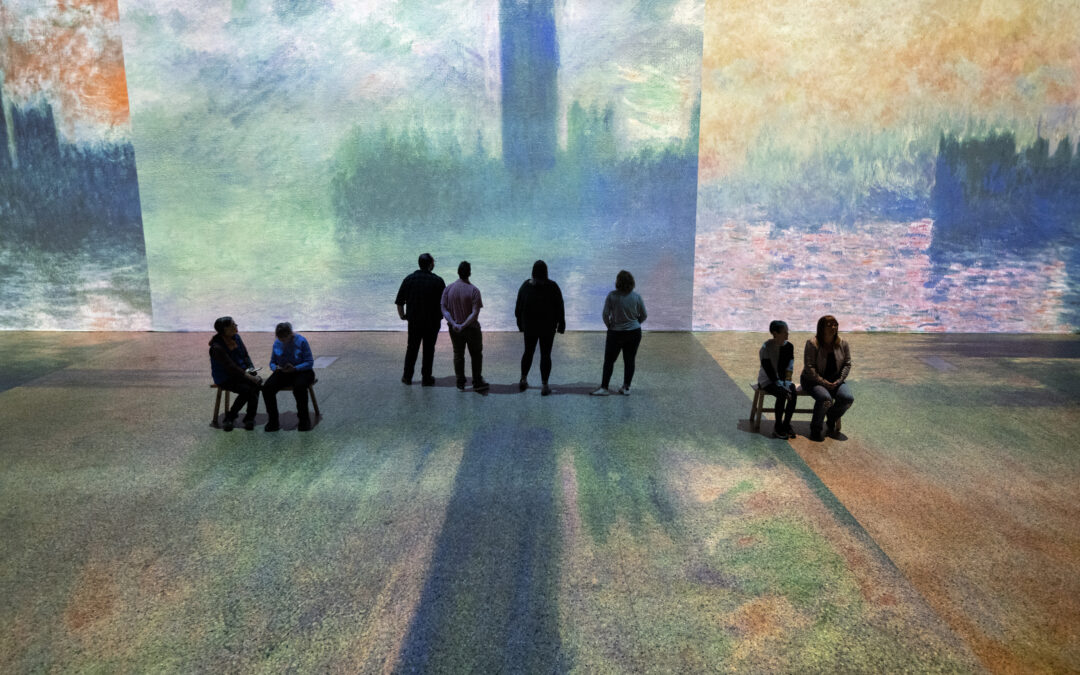By Jim Roberts
More than 50,000 people attended the “Beyond Van Gogh” immersive art exhibit in Virginia Beach in 2023, so it’s little surprise that the Virginia Arts Festival and Canada’s Paquin Entertainment Group are back this year with “Beyond Monet,” a celebration of the founder of Impressionism. We had a chance to talk with Fanny Curtat, the French art historian and consultant who helped develop both shows.
Veer Magazine: Is there anything unique about the space in Virginia Beach, or do you just need a large footprint, and the show is the same anywhere you go?
Curtat: The content in and of itself is the same. However, the screen and the space, it does vary a little bit. We need an enormous footprint to make it happen. It’s a minimum of 30,000 square feet, so the convention center is particularly well adapted for that. It’s a perfect space and allows for the experience to be wide and really as immersive as it can be. The more space you have, the more you have this awe-inspiring feeling of being inside the paintings themselves and just being part of the world as it moves around you. … But you also need a good response from the community. You need enthusiasm, which has been great. The team has been fantastic in Virginia Beach. It’s been really, really lovely. That’s why the producers came back with the second project—because it went so well the first time around.
Veer Magazine: Being involved in every step of the process—selecting the works, seeing it animated by the team and then bringing it to life in the exhibit—what does that feel like to see it for the first time? Not only the first time, but multiple times over and over again?
Curtat: It’s actually quite phenomenal! For the longest time, you work on this on your own computer. I had ideas of the show and everything on my laptop, but when you see it in the space and when you see it with people around you, that’s really, truly when it becomes purposeful. The first time we opened it in Toronto, it was just pure magic to have all of these works surround you—especially certain scenes, like the poplar trees or the haystacks. To see the series showcased in that way, you just appreciate so much the nuances of what Monet was doing. It was truly spectacular. But then, this emotion is kept alive by the fact that every time I see it, I see it with audience members in it, with people in it, with kids in it, with a lot of different emotions that people go through when they are in the presence of any type of art. It is really, really a privilege to be able to see that.
Veer Magazine: What did you learn from the Van Gogh exhibit that maybe you improved upon with the Monet exhibit?
Curtat: It was really about seeing the rhythms of the show—how you build it—because there is something so efficient about Van Gogh’s work. You see clear evolution regarding his work as it changes according to different cities where he’s lived—so there is this progression. We learned from that how impossible it was to adapt the same formula from one to the other. … For example, Van Gogh was this natural evolution that’s really mostly chronological. That didn’t translate as well with Monet. So it was really about refocusing everything. So you sort of learn to unlearn when you go from the Van Gogh experience to the Monet one.
Veer Magazine: As a historian, do you wrestle at all with the balance of seeing the original piece in person versus creating these digital experiences?
Curtat: There is an enormous debate in the art world, and there should be because that’s what the art world is for. … I never think that an experience like this should be seen as a replacement to a museum experience. There is nothing like the aura of an original Monet or an original Van Gogh. There is magic there—you can feel it. But we do have to recognize that technology is sort of a tide at this point. It’s going everywhere, so you might as well go with it and see what it can add. … My hope is that an experience like this would help connect the dots. After you’ve spent half an hour or an hour inside the work of a painter like Monet or Van Gogh, next time you get to a town that has an exhibit with original paintings on their walls, maybe they’ll be curious about experiencing that as well. … After being literally in the middle of the pond with the lilies flowing all around you, maybe, if you are in New York and you go to MoMA, you’ll spend time in that incredible, incredible room where you have the water lilies around you that makes me cry every single time I go there. So there is something to be said about seeing where these sort of devices, these sort of tools can help fill certain gaps in terms of how the art world reaches a wider audience.
Veer Magazine: Is there anything else you want to share?
Curtat: Just that it is truly for everyone. You don’t need to know anything about Monet to enjoy an experience like this. It is about discovering his work in a different angle. It is about being in it. It’s great if you already do know his work and are already fascinated by him like I was, and you’re just in a painting you know and love—there’s sort of a fantasy to that—but it’s great for an introduction to the art world.
Beyond Monet runs through Sept. 5 at the Virginia Beach Convention Center. (The exhibit is closed on Mondays and Tuesdays.) Ticket prices start at $36. For tickets or more information, visit: beyondmonet.com




